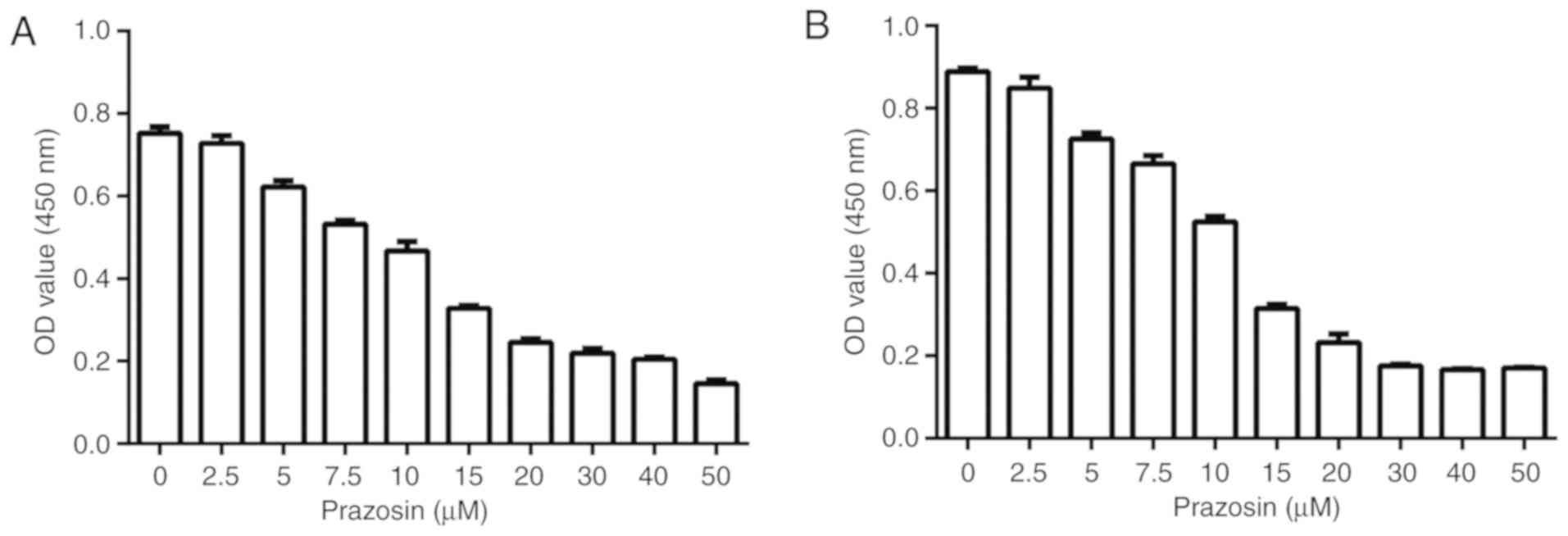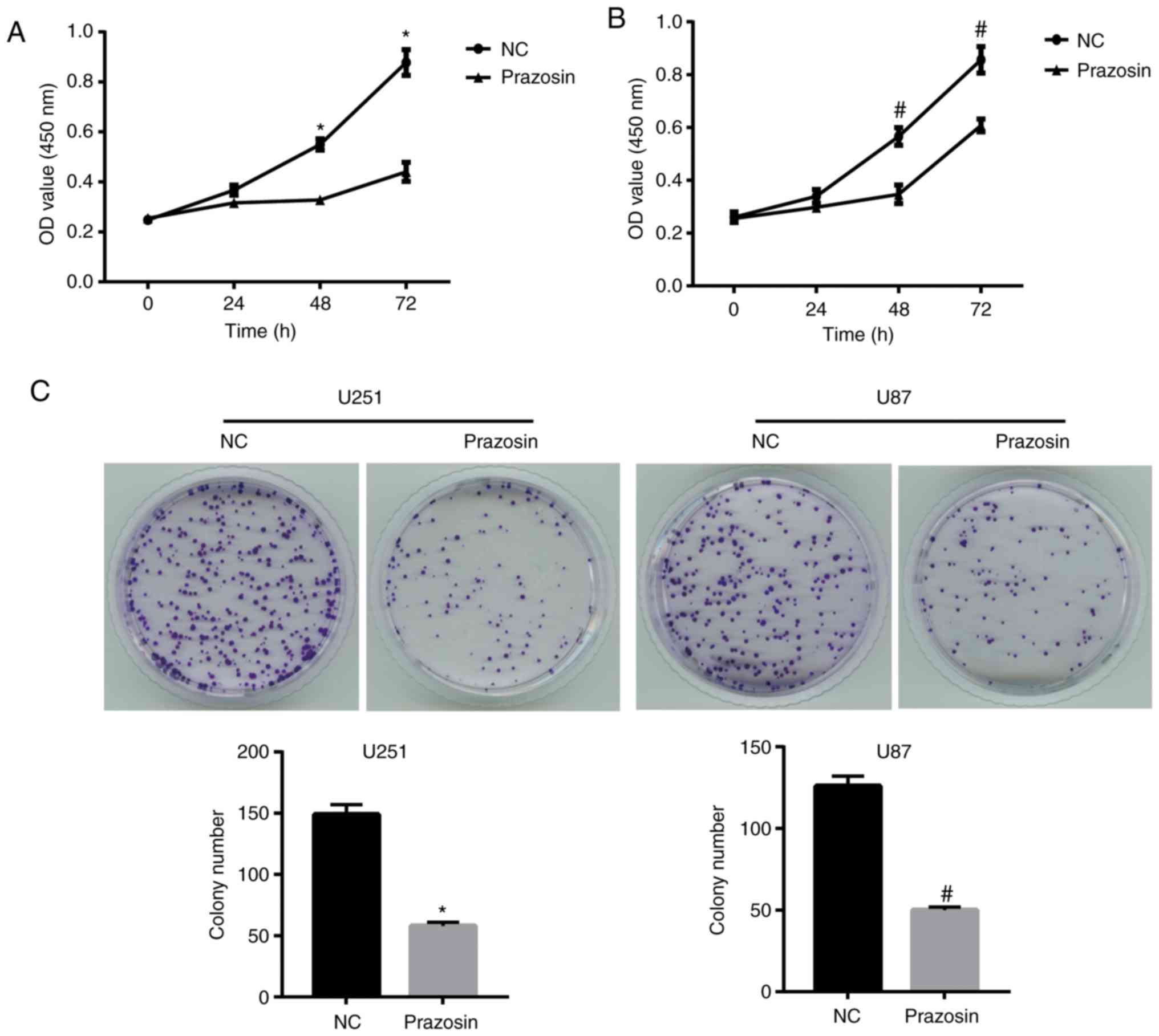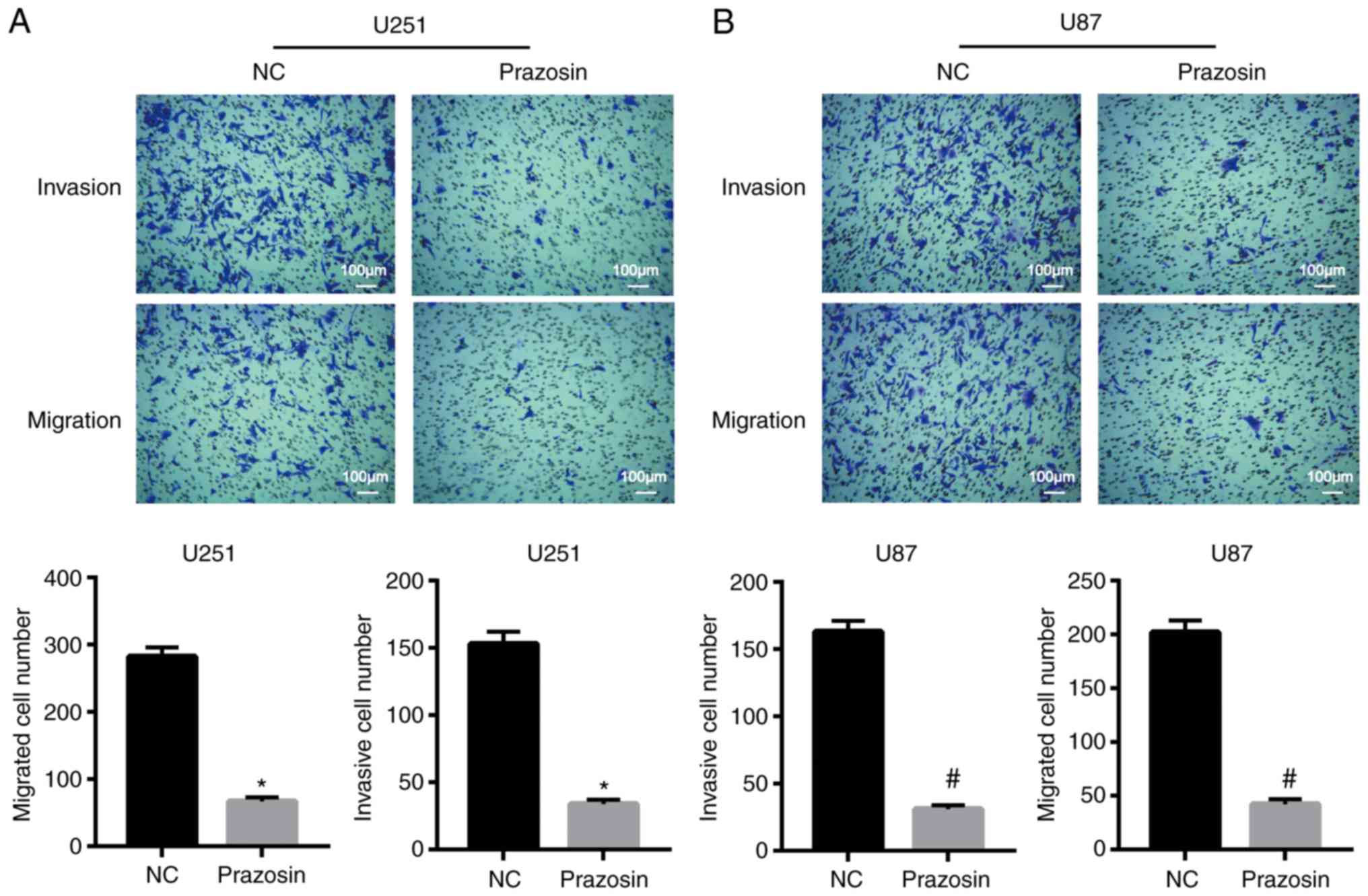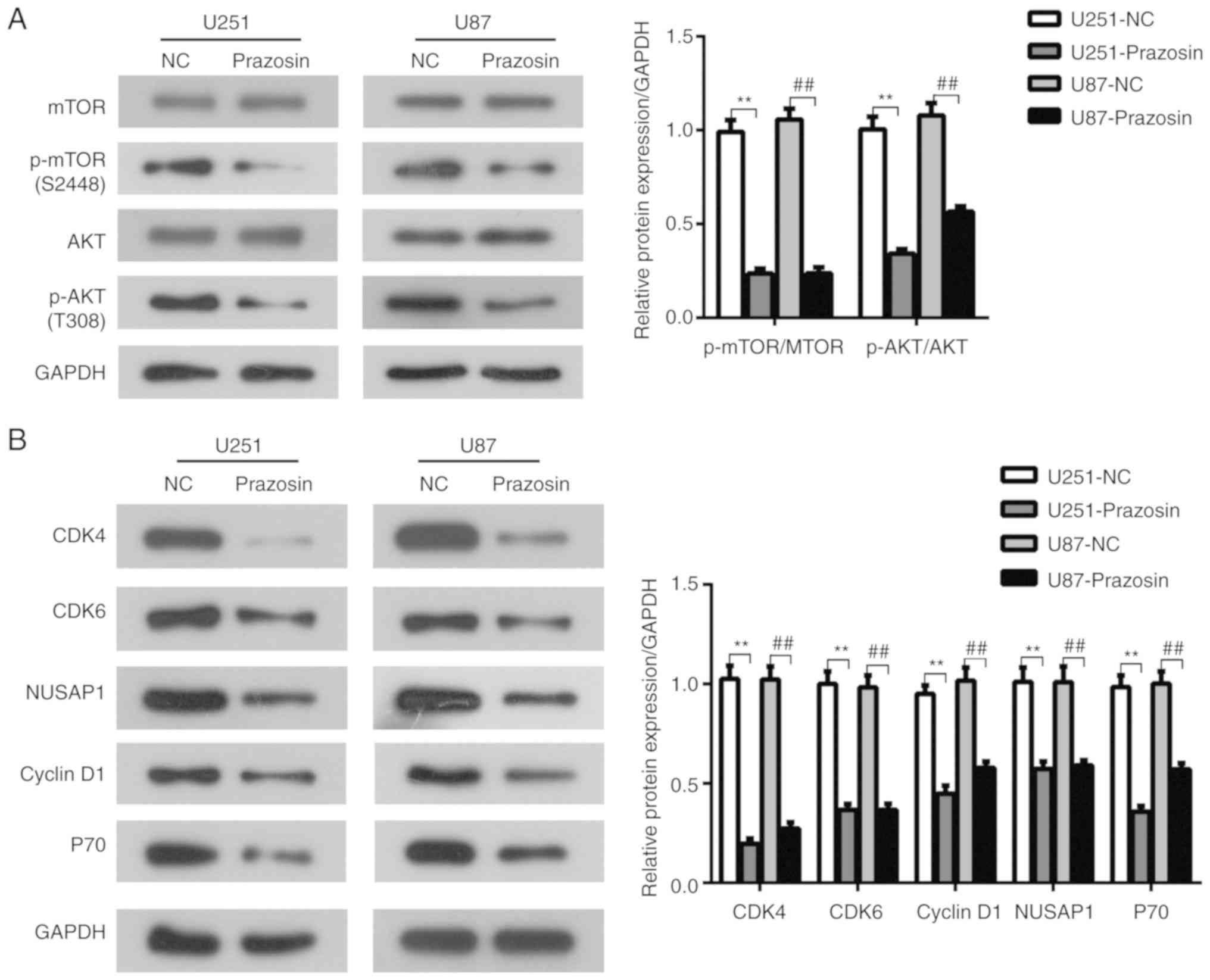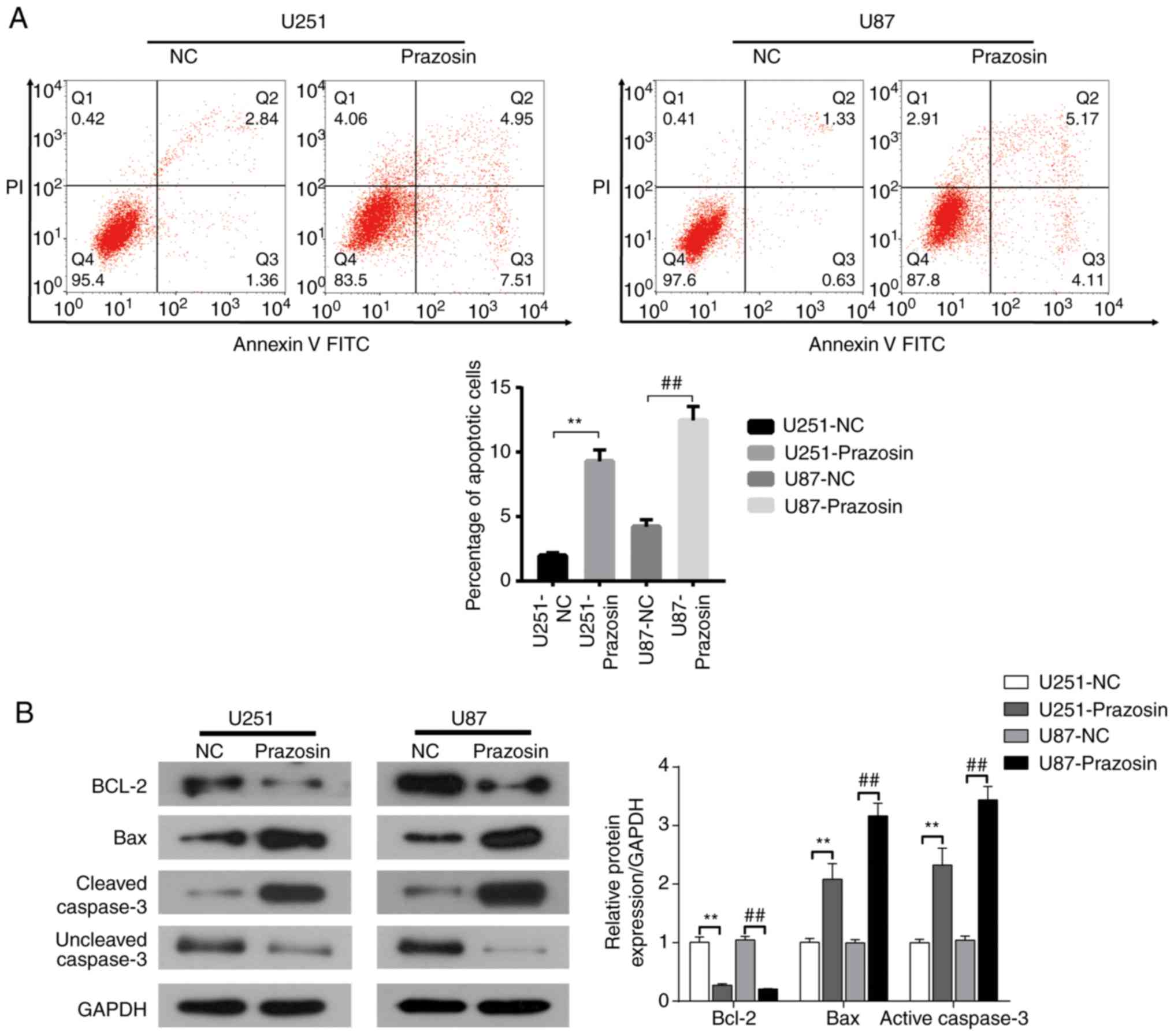Prazosin inhibits the proliferation, migration and invasion, but promotes the apoptosis of U251 and U87 cells via the PI3K/AKT/mTOR signaling pathway
- Authors:
- Published online on: May 19, 2020 https://doi.org/10.3892/etm.2020.8772
- Pages: 1145-1152
Abstract
Introduction
Among the most common primary malignant tumors of the brain, human glioblastoma accounts for ~40% of intracranial tumors (1). The main clinical features of glioblastoma include high malignancy, a high relapse rate and poor prognosis (2). Local abnormal proliferation and infiltration of human glioblastoma cells in the brain is the main cause of death in patients, and at present, there are no safe and effective treatments for the disease (3). Despite significant advances in treatment strategies, including surgical resection, radiotherapy and chemotherapy, the overall 5-year survival rate for patients with glioblastoma remains poor (~10%) (4). Currently, there are only two drugs clinically used for the standardized treatment of human glioblastoma, temozolomide and carmustine; however, both drugs display serious side effects (5). Therefore, identifying novel therapeutics for human glioblastoma is essential.
As a member of the G-protein coupled receptor superfamily, adrenergic receptors play an important role in the sympathetic nervous system (6). There are three subtypes of adrenergic receptors: α1A, α1B and α1D (7). Commonly used adrenergic receptor antagonists include quinazoline-based prazosin, doxazosin and terazosin, as well as the sulfonamide derivative tamsulosin. The aformentioned drugs are not only used to treat essential hypertension (8), but are also used for the treatment of prostate cancer as they inhibit progression, induce apoptosis and reduce prostate specific antigen levels (9,10). Kyprianou et al (8) reported for the first time that α-adrenergic antagonists can induce apoptosis in the glandular epithelium and smooth muscle, which are present in benign prostatic hyperplasia (8). Further studies have reported that α-adrenergic antagonists can also induce apoptosis in malignant prostate cancer cells (11-13). Based on the aforementioned studies, further investigation into the effects of α1-adrenergic antagonists on other human malignancies, including mesothelioma, as well as breast and bladder cancer, has been conducted (14-16). These further studies have reported that α-adrenergic antagonists have a significant proapoptotic effect on malignant tumors. Doxazosin is an α-adrenergic receptor blocker that inhibits tumor growth and angiogenesis (17,18). Prazosin is also an α-adrenergic antagonist used to treat essential hypertension and although the effects of prazosin on human glioblastoma have been reported, the underlying mechanism remains unclear (19). In the present study, the potential antitumor effects of prazosin in glioblastoma cells were investigated. Referring to recently published studies investigating the mechanism underlying glioblastoma progression, U251 and U87 cell lines were used in the present study (20,21). Furthermore, the PI3K/AKT signaling pathway was investigated as a potential molecular mechanism underlying the effects of prazosin on glioblastoma cells.
Materials and methods
Cell lines and cell culture
Human malignant glioblastoma cell lines U251MG (astrocytoma) and U87 (glioblastoma of unknown origin) were purchased from Nianjing KeyGen Biotech Co., Ltd. U87 cells were authenticated by a short tandem repeat profiling method using the PowerPlex 18D system kit (cat. no. DC1802; Promega Corporation) and an ABI 3500 Genetic analyzer (Applied Biosystems; Thermo Fisher Scientific, Inc.). Cells were cultured in DMEM (HyClone; GE Healthcare Life Sciences) supplemented with 10% fetal bovine serum (FBS; Gibco; Thermo Fisher Scientific, Inc.) and 1% penicillin/streptomycin (Beijing Solarbio Science & Technology, Co., Ltd.) at 37˚C with 5% CO2.
Drug sensitivity assays
U251 and U87 cells were seeded (1x103 cells/well) into 96-well microtiter plates containing 100 µl culture medium. Prazosin was dissolved in DMSO to 10 different concentrations: 0, 2.5, 5, 7.5, 10, 15, 20, 30, 40 and 50 µM. Different concentrations of prazosin were added to each well and incubated for 48 h at 37˚C. Subsequently, 10 µl Cell Counting Kit-8 (CCK-8) reagent (Beijing Solarbio Science & Technology Co., Ltd.) was added to each well and the plates were incubated for 1.5 h at 37˚C. The optical density value of each well was detected at a wavelength of 450 nm using a microplate reader and a dose-response curve was plotted. The IC50 concentration of prazosin was calculated using GraphPad Prism software (version 7; GraphPad Software, Inc.). Each drug concentration was tested 3 times.
CCK-8 assay for cell proliferation
U251 and U87 cells were seeded (1x103 cells/well) into 96-well plates and cultured for 24 h at 37˚C with 5% CO2. U251 and U87 cells were treated with 13.16 and 11.57 µM prazosin, respectively. Cells were incubated for 24, 48 or 72 h 37˚C. Subsequently, 10 µl CCK-8 solution was added to each well and the plates were incubated for 1.5 h at 37˚C. The absorbance was measured at a wavelength of 450 nm using a microplate reader.
Cell invasion and migration assays
The upper chamber of the Transwell plate was precoated with Matrigel® for 30 min at 70˚C. Subsequently, the Transwell membrane was hydrated with serum-free medium containing 10 g/l bovine serum albumin (BSA; Sigma-Aldrich; Merck KGaA) for 30 min at 37˚C. Prior to plating, 1x105 U251 or U87 cells were serum-starved for 12-24 h at 37˚C. Subsequently, cells were detached by trypsinization and resuspended in serum-free medium containing 10 g/l BSA. Cell invasion was evaluated using Transwell invasion assays. Subsequently, cells treated with prazosin for 24 h at 37˚C (1x105) were seeded into the upper chambers. Medium containing 10% FBS (500 µl) was plated in the lower chamber of the Transwell plates. Following incubation at 37˚C for 24 h, the invading cells were fixed with 4% paraformaldehyde for 10 min at room temperature and stained with 0.1% crystal violet for 20 min at room temperature. Stained cells were counted in five randomly-selected fields using a light microscope (magnification, x200).
The Transwell migration assay followed the same protocol as the Transwell invasion assay, however, the Transwell membranes were not precoated with Matrigel and 5x103 cells were plated in the upper chamber of the Transwell plates.
Cell apoptosis assay
Following treatment with prazosin for 24 h, U251 and U87 cells were resuspended in binding buffer (5x106 cells/ml; CoWin Biosciences). Cells were stained with 5 µl annexin V-FITC and 10 µl propidium iodide (CoWin Biosciences) in the dark at room temperature for 5 min. Subsequently, the cell suspensions were centrifuged for 5 min at 4˚C and a speed of 447 x g, the supernatant was discarded and the pellets were resuspended in 400 µl PBS. Apoptotic cells were analyzed using a flow cytometer (BD Biosciences) and FlowJo software 7.6.1 (FlowJo, LLC).
Colony formation assay
U251 and U87 cells in the logarithmic growth phase were trypsinized, seeded (2x102 cells/dish) into 35 mm cell culture dishes and gently rotated to uniformly disperse the cells. Cells were suspended in DMEM containing 10% FBS. Subsequently, complete medium containing prazosin (IC50 concentration: U251, 13.16 µM; U87, 11.57 µM) was added to the experimental group and the same concentration of DMSO was added to the control group. The cells were cultured for 2-3 weeks at 37˚C. When macroscopic clones appeared in the culture dish, the medium was discarded and the cells were carefully washed three times with PBS. The cells were fixed with 4% paraformaldehyde for 20 min at room temperature and stained with crystal violet for 30 min at room temperature. Colony number was counted in 5 random fields of view using a light microscope (magnification, x40).
Western blot analysis
U251 and U87 cells were treated with prazosin for 48 h at 37˚C. Total protein was extracted from the cells using RIPA buffer (CoWin Biosciences). Total protein was quantified using a bicinchoninic acid assay. Protein (20 mg) was separated by 10% SDS-PAGE and transferred to PVDF membranes. Subsequently, the membranes were blocked with 5% fat-free milk for 1 h at room temperature. The membranes were incubated overnight at 4˚C with primary antibodies targeted against the following: AKT (cat. no. ab18785; 1:2,000; Abcam), phosphorylated (p)-AKT (cat. no. ab38449; 1:1,000; Abcam), mTOR (cat. no. ab2732; 1:1,000; Abcam), p-mTOR (cat. no. ab109268; 1:1,000; Abcam), Bcl-2 (cat. no. 12789-1-AP; 1:1,000; ProteinTech Group, Ltd.), Bax (cat. no. 50599-2-Ig; 1:1,000; ProteinTech Group, Ltd.), Caspase-3 (cat. no. ab32351; 1:1,000; Abcam), cyclin D1 (cat. no. ab134175; 1:1,000; Abcam), P70 (cat. no. ab184551, 1:1,000; Abcam) CDK4 (cat. no. ab108357; 1:1,000; Abcam), CDK6 (cat. no. ab124821; 1:1,000; Abcam), NUSAP1 (cat. no. ab169083; 1:500; Abcam) and GAPDH (cat. no. 10494-1-AP; 1:5,000; ProteinTech Group, Ltd.). Subsequently, the membranes were incubated with an anti-Rabbit secondary antibody (cat. no. ab6721; 1:5,000; Abcam) for 1 h at room temperature. Protein bands were visualized by ECL (CoWin Biosciences). Protein expression was quantified using Quantity One 4.6.6 (Bio-Rad Laboratories, Inc.) and Image J 1.41 (National Institutes of Health) software with GAPDH as the loading control.
Statistical analysis
Statistical analyses were performed using SPSS software (version 18.0; SPSS, Inc.). Data are presented as the mean ± SD. Differences were assessed using an unpaired Student's t-test. P<0.05 was considered to indicate a statistically significant difference. All experiments were performed in triplicate.
Results
Dose-response experiment to determine the IC50 of prazosin
A dose-response experiment was conducted to investigate whether prazosin inhibited the proliferation of U87 and U251 cells. The IC50 of prazosin for glioblastoma cells was also determined using a CCK-8 assay. The IC50 was 13.16±0.95 and 11.57±0.79 µM prazosin for U251 and U87 cells, respectively (Fig. 1).
Prazosin inhibits U251 and U87 cell proliferation
To investigate the potential antitumor effects of prazosin, the proliferation of U251 and U87 cells treated with 13.16 and 11.57 µM prazosin, respectively, for 24, 48 or 72 h was assessed. The results suggested that prazosin significantly decreased the proliferation of U251 and U87 cells after treatment for 48 and 72 h (Fig. 2A and B).
Furthermore, the colony formation assay suggested that prazosin-treated U251 and U87 cells displayed significantly decreased colony formation compared with the NC group (58±3 vs. 149±8 and 50±2 vs. 126±6, respectively; Fig. 2C). The colony number of prazosin-treated U251 and U87 cells displayed a similar trend to colony formation (11.6 vs. 29.8 and 10 vs. 25.2%, respectively; P<0.05; Fig. 2C). Therefore, the results suggested that prazosin effectively inhibited the proliferation of U251 and U87 cells.
Prazosin inhibits U251 and U87 cell invasion and migration
The effect of prazosin on the migration and invasion of U251 and U87 cells was detected using Transwell assays. The migratory ability of U251 and U87 cells was significantly decreased following prazosin treatment compared with the negative control cells (282±14 vs. 67±6 and 202±11 vs. 42±5, respectively; P<0.05; Fig. 3). The invasive ability of U251 and U87 cells decreased significantly following prazosin treatment compared with the negative control cells (153±9 vs. 34±3 and 163±8 vs. 31±3; P<0.05; Fig. 3A). The results indicated that prazosin inhibited the migration and invasion of U251 and U87 cells.
Prazosin suppresses the PI3K/AKT/mTOR signaling pathway in U251 and U87 cells
The PI3K/AKT/mTOR signaling pathway plays a key role in the regulation of cell proliferation (22). To investigate the effects of prazosin on the PI3K/AKT/mTOR signaling pathway in glioblastoma, U251 and U87 cells were treated with prazosin and protein expression levels were determined by western blotting. Following prazosin treatment, the expression of p-AKT and p-mTOR was significantly reduced in U251 and U87 cells compared with the negative control cells (P<0.05; Fig. 4A). Furthermore, the expression levels of P70 and cyclin D1, which are downstream target genes of the PI3K/AKT/mTOR signaling pathway (23), were decreased in prazosin-treated cells compared with negative control cells (P<0.05; Fig. 4B). The results suggested that prazosin treatment decreased the protein expression of components of the PI3K/AKT/mTOR signaling pathway in U251 and U87 cells.
Based on the result that cyclin D1 expression was reduced by prazosin treatment, the expression levels of cell cycle related genes, cyclin dependent kinase (CDK)4/6 and nucleolar and spindle associated protein 1 (NUSAP1), were measured to investigate whether prazosin affected the cell cycle. The expression levels of CDK4/6 and NUSAP1 were significantly decreased in the prazosin treatment groups compared with the NC groups (P<0.05; Fig. 4B). The results suggested that prazosin may inhibit the proliferation of U251 and U87 cells by blocking the cell cycle.
Prazosin induces apoptosis in U251 and U87 cells
The effect of prazosin on U251 and U87 cell apoptosis was detected by flow cytometry. The percentage of apoptotic U251 and U87 cells was significantly increased in the prazosin treatment groups compared with the NC groups (9.28±0.89 vs. 1.96±0.23 and 12.46±1.07 vs. 4.20±0.56%, respectively; Fig. 5A). Western blot analysis indicated that the expression of the antiapoptotic protein Bcl2 was decreased, and the expression of the proapoptotic proteins Bax and active Caspase-3 was increased in the prazosin treatment groups compared with the NC groups (Fig. 5B). The results suggested that prazosin induced apoptosis in U251 and U87 cells, indicating that the antitumor activity of prazosin may be related to apoptosis induction.
Discussion
To the best of our knowledge, the present study suggested for the first time that prazosin inhibits the proliferation, migration and invasion of U251 and U81 cells via the PI3K/AKT/mTOR signaling pathway.
Glioblastoma is one of the most common adult malignant brain tumors worldwide, with a median survival time of 13-15 months (24). At present, there are no safe and effective treatments for the disease, and the standard treatment involves a combination of surgery, radiotherapy and chemotherapy (25). However, the standard therapeutic strategies display a number of problems and limitations: i) Glioblastoma invades the adjacent brain parenchyma, which makes it difficult to completely remove the tumor (26); ii) orthotropic tumors grow malignantly, which causes surrounding tumors to grow and leads to brain tissue edema, which is one of the major causes of the high mortality rate observed in patients with glioblastoma (27); iii) the maximum dose of radiation does not completely eradicate tumor cells (27); iv) movement, language and cognitive deficits can occur following surgery, resulting in poor patient quality of life and increased mortality (28,29); and v) the anatomy of the human brain, for example, the blood-brain barrier, limits the efficacy of cancer therapeutics (30). Therefore, there is an urgent requirement for the identification of novel therapeutic targets for glioblastoma.
Previous studies have reported that the activation of α1-adrenergic receptors increases the proliferation of nerve cells, vascular smooth muscle cells and vascular endothelial cells during development (31-35). Furthermore, it has been reported that α1-adrenergic receptors play a crucial role in embryonic brain development (36). In the present study, U251 and U87 cells were treated with prazosin to investigate the effect of the drug on human glioblastoma in vitro. Prazosin inhibited the proliferation, migration and invasion of U251 and U87 cells, as indicated by CCK-8, colony formation and Transwell assays. However, a limitation of the present study is that the Transwell assay detects the 3D migration of cells, whereas the wound healing assay, which detects the horizontal migration of cells, was not performed in the present study.
The molecular mechanism underlying the anticancer activity of prazosin on human glioblastoma cells was also investigated. The PI3K/AKT/mTOR signaling pathway plays a crucial role in tumor cell proliferation, migration, invasion and apoptosis (22). Numerous studies have reported that the PI3K/AKT/mTOR signaling pathway is abnormally activated during human glioblastoma (23,37). mTOR is a downstream molecule in the PI3K/AKT signaling pathway that plays a key role in the activation of P70 and cyclin D1(38), which are associated with apoptosis (39,40). The results of the present study indicated that the expression levels of p-AKT, p-mTOR, P70 and cyclin D1 were significantly reduced in the prazosin-treated group compared with the control group, suggesting that prazosin inhibited the PI3K/AKT/mTOR signaling pathway in U251 and U87 cells.
Both doxazosin and terazosin are clinically effective α1-adrenergic receptor antagonists that trigger tumor apoptosis (41). A number of previous studies have reported that quinazoline-derived α1-adrenergic receptor antagonists display anti-prostate cancer effects. In addition, doxazosin induces apoptosis and inhibits angiogenesis (11,42-45). The results of the present study suggested that prazosin increased the expression of proapoptotic proteins Bax and Caspase-3, and decreased the expression of the antiapoptotic protein Bcl-2. The results were consistent with the effect of prazosin on apoptosis, as determined by flow cytometry, which indicated that the percentage of apoptotic cells was increased in the prazosin-treated group compared with the control group.
In conclusion, the present study suggested that prazosin inhibited the proliferation, migration and invasion, and promoted the apoptosis of U251 and U87 cells by inhibiting the PI3K/AKT/mTOR signaling pathway.
Acknowledgements
Not applicable.
Funding
No funding was received.
Availability of data and materials
The datasets used and/or analyzed during the present study are available from the corresponding author on reasonable request.
Authors' contributions
JZ and JF designed the experiments. JZ performed the experiments; JZ and JF analyzed the data and wrote the manuscript. All authors read and approved the final manuscript.
Ethics approval and consent to participate
Not applicable.
Patient consent for publication
Not applicable.
Competing interests
The authors declare that they have no competing interests.
References
|
Rousseau A, Mokhtari K and Duyckaerts C: The 2007 WHO classification of tumors of the central nervous system-what has changed? Curr Opin Neurol. 21(720)2008.PubMed/NCBI View Article : Google Scholar | |
|
Chargari C, Feuvret Lc, Bauduceau O, Ricard D, Cuenca X, Delattre JY and Mazeron JJ: Treatment of elderly patients with glioblastoma: From clinical evidence to molecular highlights. Cancer Treat Rev. 38:988–995. 2012.PubMed/NCBI View Article : Google Scholar | |
|
Franceschi E, Ermani M, Bartolini S, Bartolotti M, Poggi R, Tallini G, Marucci G, Fioravanti A, Tosoni A, Agati R, et al: Post progression survival in glioblastoma: Where are we? J Neurooncol. 121:399–404. 2015.PubMed/NCBI View Article : Google Scholar | |
|
Radin DP, Purcell R and Lippa AS: Oncolytic properties of ampakines in vitro. Anticancer Res. 38:265–269. 2018.PubMed/NCBI View Article : Google Scholar | |
|
Stupp R, Mason WP, van den Bent MJ, Weller M, Fisher B, Taphoorn MJ, Belanger K, Brandes AA, Marosi C, Bogdahn U, et al: Radiotherapy plus concomitant and adjuvant temozolomide for glioblastoma. N Engl J Med. 352:987–996. 2005.PubMed/NCBI View Article : Google Scholar | |
|
Piascik MT and Perez DM: Alpha1-adrenergic receptors: New insights and directions. J Pharmacol Exp Ther. 298:403–410. 2001.PubMed/NCBI | |
|
Salomonsson M, Oker M, Kim S, Zhang H, Faber JE and Arendshorst WJ: Alpha1-adrenoceptor subtypes on rat afferent arterioles assessed by radioligand binding and RT-PCR. Am J Physiol Renal Physiol. 281:F172–F178. 2001.PubMed/NCBI View Article : Google Scholar | |
|
Kyprianou N, Litvak JP, Borkowski A, Alexander R and Jacobs SC: Induction of prostate apoptosis by doxazosin in benign prostatic hyperplasia. J Urol. 159:1810–1815. 1998.PubMed/NCBI | |
|
Cal C, Uslu R, Gunaydin G, Ozyurt C and Omay SB: Doxazos in: A new cytotoxic agent for prostate cancer? BJU Int. 85:672–675. 2000.PubMed/NCBI View Article : Google Scholar | |
|
Kyprianou N and Benning CM: Suppression of human prostate cancer cell growth by alpha1-adrenoceptor antagonists doxazosin and terazosin via induction of apoptosis. Cancer Res. 60(4550)2000.PubMed/NCBI | |
|
Benning CM and Kyprianou N: Quinazoline-derived alpha1-adrenoceptor antagonists induce prostate cancer cell apoptosis via an alpha1-adrenoceptor-independent action. Cancer Res. 62:597–602. 2002.PubMed/NCBI | |
|
Partin JV, Anglin IE and Kyprianou N: Quinazoline-based α1-adrenoceptor antagonists induce prostate cancer cell apoptosis via TGF-β signalling and IκBα induction. Br J Cancer. 88:1615–1621. 2003.PubMed/NCBI View Article : Google Scholar | |
|
Cuellar DC, Rhee J and Kyprianou N: Alpha1-adrenoceptor antagonists radiosensitize prostate cancer cells via apoptosis induction. Anticancer Res. 22:1673–1679. 2002.PubMed/NCBI | |
|
Hui H, Fernando MA and Heaney AP: The alpha1-adrenergic receptor antagonist doxazosin inhibits EGFR and NF-kappaB signalling to induce breast cancer cell apoptosis. Eur J Cancer. 44:160–166. 2008.PubMed/NCBI View Article : Google Scholar | |
|
Siddiqui EJ, Shabbir M, Thompson CS, Mumtaz FH and Mikhailidis DP: Growth inhibitory effect of doxazosin on prostate and bladder cancer cells. Is the serotonin receptor pathway involved? Anticancer Res. 25(4281)2005.PubMed/NCBI | |
|
Masachika E, Kanno T, Nakano T, Gotoh A and Nishizaki T: Naftopidil induces apoptosis in malignant mesothelioma cell lines independently of alpha1-adrenoceptor blocking. Anticancer Res. 33:887–894. 2013.PubMed/NCBI | |
|
Park MS, Kim BR, Dong SM, Lee SH, Kim DY and Rho SB: The antihypertension drug doxazosin inhibits tumor growth and angiogenesis by decreasing VEGFR-2/Akt/mTOR signaling and VEGF and HIF-1α expression. Oncotarget. 5:4935–4944. 2014.PubMed/NCBI View Article : Google Scholar | |
|
Hu ZW, Shi XY, Lin RZ, Chen J and Hoffman BB: alpha1-Adrenergic receptor stimulation of mitogenesis in human vascular smooth muscle cells: Role of tyrosine protein kinases and calcium in activation of mitogen-activated protein kinase. J Pharmacol Exp Ther. 290:28–37. 1999.PubMed/NCBI | |
|
Assad Kahn S, Costa SL, Gholamin S, Nitta RT, Dubois LG, Fève M, Zeniou M, Coelho PL, El-Habr E, Cadusseau J, et al: The anti-hypertensive drug prazosin inhibits glioblastoma growth via the PKCδ-dependent inhibition of the AKT pathway. EMBO Mol Med. 8:511–526. 2016.PubMed/NCBI View Article : Google Scholar | |
|
Oh SJ, Yang JI, Kim O, Ahn EJ, Kang WD, Lee JH, Moon KS, Lee KH and Cho D: Human U87 glioblastoma cells with stemness features display enhanced sensitivity to natural killer cell cytotoxicity through altered expression of NKG2D ligand. Cancer Cell Int. 17(22)2017.PubMed/NCBI View Article : Google Scholar | |
|
Wang J, Liu K, Wang XF and Sun DJ: Juglone reduces growth and migration of U251 glioblastoma cells and disrupts angiogenesis. Oncol Rep. 38:1959–1966. 2017.PubMed/NCBI View Article : Google Scholar | |
|
Liu Z, Wang F, Zhou ZW, Xia HC, Wang XY, Yang YX, He ZX, Sun T and Zhou SF: Alisertib induces G2/M arrest, apoptosis, and autophagy via PI3K/Akt/mTOR- and p38 MAPK-mediated pathways in human glioblastoma cells. Am J Transl Res. 9:845–873. 2017.PubMed/NCBI | |
|
Iżycka-Świeszewska E, Drożyńska E, Rzepko R, Kobierska-Gulida G, Grajkowska W, Perek D and Balcerska A: Analysis of PI3K/AKT/MTOR signalling pathway in high risk neuroblastic tumours. Pol J Pathol. 61:192–198. 2010.PubMed/NCBI | |
|
Horvath S, Zhang B, Carlson M, Lu KV, Zhu S, Felciano RM, Laurance MF, Zhao W, Qi S, Chen Z, et al: Analysis of oncogenic signaling networks in glioblastoma identifies ASPM as a molecular target. Proc Natl Acad Sci USA. 103:17402–17407. 2006.PubMed/NCBI View Article : Google Scholar | |
|
Davis ME: Glioblastoma: Overview of disease and treatment. Clin J Oncol Nurs. 20 (Suppl):S2–S8. 2016.PubMed/NCBI View Article : Google Scholar | |
|
D'Alessandro G, Catalano M, Sciaccaluga M, Chece G, Cipriani R, Rosito M, Grimaldi A, Lauro C, Cantore G, Santoro A, et al: KCa3.1 channels are involved in the infiltrative behavior of glioblastoma in vivo. Cell Death Dis. 4(e773)2013.PubMed/NCBI View Article : Google Scholar | |
|
Wirth T, Samaranayake H, Pikkarainen J, Määttä AM and Yläherttuala S: Clinical trials for glioblastoma multiforme using adenoviral vectors. Curr Opin Mol Ther. 11:485–492. 2009.PubMed/NCBI | |
|
Jakola AS, Gulati S, Weber C, Unsgård G and Solheim O: Postoperative deterioration in health related quality of life as predictor for survival in patients with glioblastoma: A prospective study. PLoS One. 6(e28592)2011.PubMed/NCBI View Article : Google Scholar | |
|
Mcgirt MJ, Mukherjee D, Chaichana KL, Than KD, Weingart JD and Quinones-Hinojosa A: Association of surgically acquired motor and language deficits on overall survival after resection of glioblastoma multiforme. Neurosurgery. 65:463–470. 2009.PubMed/NCBI View Article : Google Scholar | |
|
Juillerat-Jeanneret L: The targeted delivery of cancer drugs across the blood-brain barrier: Chemical modifications of drugs or drug-nanoparticles? Drug Discov Today. 13:1099–1106. 2008.PubMed/NCBI View Article : Google Scholar | |
|
Popovik E and Haynes L: Survival and mitogenesis of neuroepithelial cells are influenced by noradrenergic but not cholinergic innervation in cultured embryonic rat neopallium. Brain Res. 853:227–235. 2000.PubMed/NCBI View Article : Google Scholar | |
|
Chen L, Xin X, Eckhart AD, Yang N and Faber JE: Regulation of vascular smooth muscle growth by alpha 1-adrenoreceptor subtypes in vitro and in situ. J Biol Chem. 270:30980–30988. 1995.PubMed/NCBI View Article : Google Scholar | |
|
Faber JE, Yang N and Xin X: Expression of alpha-adrenoceptor subtypes by smooth muscle cells and adventitial fibroblasts in rat aorta and in cell culture. J Pharmacol Exp Ther. 298:441–452. 2001.PubMed/NCBI | |
|
Xin X, Yang N, Eckhart AD and Faber JE: Alpha1D-adrenergic receptors and mitogen-activated protein kinase mediate increased protein synthesis by arterial smooth muscle. Mol Pharmacol. 51:764–775. 1997.PubMed/NCBI View Article : Google Scholar | |
|
Bleeke T, Zhang H, Madamanchi N, Patterson C and Faber JE: Catecholamine-induced vascular wall growth is dependent on generation of reactive oxygen species. Circ Res. 94:37–45. 2004.PubMed/NCBI View Article : Google Scholar | |
|
Hiramoto T, Satoh Y, Takishima K and Watanabe Y: Induction of cell migration of neural progenitor cells in vitro by alpha-1 adrenergic receptor and dopamine D1 receptor stimulation. Neuroreport. 19:793–797. 2008.PubMed/NCBI View Article : Google Scholar | |
|
Westhoff MA, Karpel-Massler G, Brühl O, Enzenmüller S, La Ferla-Brühl K, Siegelin MD, Nonnenmacher L and Debatin KM: A critical evaluation of PI3K inhibition in Glioblastoma and Neuroblastoma therapy. Mol Cell Ther. 2(32)2014.PubMed/NCBI View Article : Google Scholar | |
|
Guertin DA and Sabatini DM: Defining the role of mTOR in cancer. Cancer Cell. 12:9–22. 2007.PubMed/NCBI View Article : Google Scholar | |
|
Halacli SO and Dogan AL: FOXP1 regulation via the PI3K/Akt/p70S6K signaling pathway in breast cancer cells. Oncol Lett. 9:1482–1488. 2015.PubMed/NCBI View Article : Google Scholar | |
|
Liu W, Ren H, Ren J, Yin T, Hu B, Xie S, Dai Y, Wu W, Xiao Z, Yang X and Xie D: The role of EGFR/PI3K/Akt/cyclinD1 signaling pathway in acquired middle ear cholesteatoma. Mediators Inflamm. 2013(651207)2013.PubMed/NCBI View Article : Google Scholar | |
|
Desiniotis A and Kyprianou N: Advances in the design and synthesis of prazosin derivatives over the last ten years. Expert Opin Ther Targets. 15:1405–1418. 2011.PubMed/NCBI View Article : Google Scholar | |
|
Ferrara N: Role of vascular endothelial growth factor in regulation of physiological angiogenesis. Am J Physiol Cell Physiol. 280:C1358–C1366. 2001.PubMed/NCBI View Article : Google Scholar | |
|
Meyer RD and Rahimi N: Comparative structure-function analysis of VEGFR-1 and VEGFR-2: What have we learned from chimeric systems? Ann N Y Acad Sci. 995:200–207. 2003.PubMed/NCBI View Article : Google Scholar | |
|
Meyer RD, Singh A, Majnoun F, Latz C, Lashkari K and Rahimi N: Substitution of C-terminus of VEGFR-2 with VEGFR-1 promotes VEGFR-1 activation and endothelial cell proliferation. Oncogene. 23:5523–5531. 2004.PubMed/NCBI View Article : Google Scholar | |
|
Clarke DE: Alpha adrenoceptor blockade in the treatment of benign prostatic hyperplasia: Past, present and future. Br J Urol. 82(167)1998.PubMed/NCBI |



